Skin Cancer Prevention Success Stories
Programs have found many innovative ways to help prevent skin cancer in their communities. Some highlights are provided below.
Free Sunscreen Dispensers
Vermont
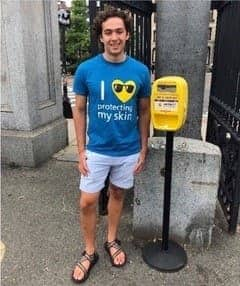
IMPACT Melanoma intern Joshua Sims Speyer stands next to a sunscreen dispenser.
Only 1 in 3 Vermont residents always uses sunscreen, even during the summer, according to a poll by IMPACT Melanoma. Those who use sunscreen often forget to apply it every 2 hours as recommended. Vermont has one of the nation’s highest rates of new cases of melanoma, the deadliest form of skin cancer.
In 2018, the Vermont Department of Health partnered with IMPACT Melanoma to add free sunscreen dispensers in 28 state and local parks and private ski areas. Each dispenser is filled with SPF 30 sunscreen and holds about 660 applications. The dispensers have messaging promoting the importance of sunscreen and are placed in areas where visitors tend to gather. The state parks also have signs about where to find the sunscreen stations along with a short message on the importance of sun safety.
“The sunscreen stations are a terrific way to deliver sun safety awareness to people when and where they most need it,” said Deb Girard, Executive Director of IMPACT Melanoma.
Rhode Island
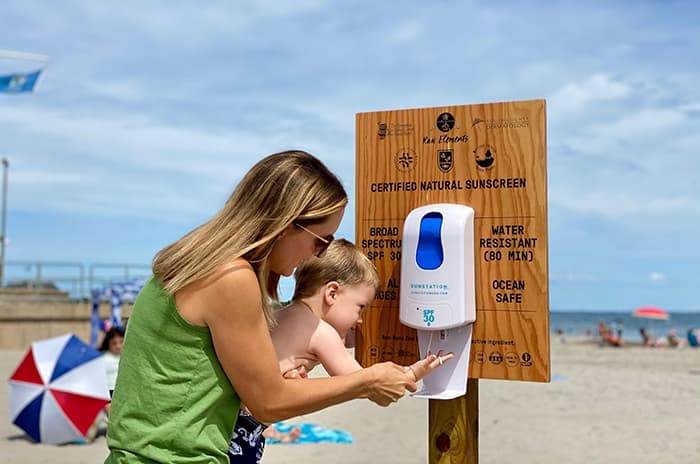
Terri Flori helps her son Kai apply sunscreen from a dispenser at Scarborough State Beach in Narragansett, Rhode Island.
In May 2019, Rhode Island installed sunscreen dispensers at eight beaches and eight state parks. During summer 2019, visitors used the dispensers more than 75,000 times. In 2020, Rhode Island converted the sunscreen pumps to touch-free dispensers to help stop the spread of COVID-19 and other diseases. In summer 2021, the program installed dispensers at two more beaches. The project aims to install sunscreen dispensers in each state park and beach, making free sunscreen available to all visitors. The department of health also hopes to bring the program to public parks in Rhode Island’s cities and towns.
Protecting marine life is also a priority for this program, so the Rhode Island Department of Health contracted with a company to provide certified natural sunscreen that protects humans from the sun without harming marine life.
“The new sunscreen dispensers are one way to help prevent more skin cancers and save more lives,” said George Andoscia, acting program manager for Rhode Island’s Comprehensive Cancer Control Program. “People can also feel more comfortable getting their sunscreen from these touch-free dispensers.”
Texas
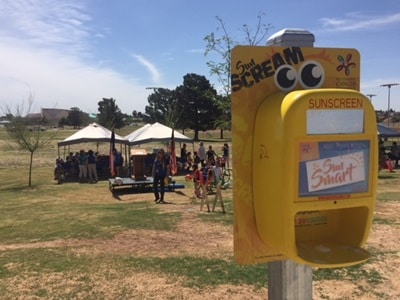
A sunscreen dispenser in El Paso, Texas. Photo courtesy of Brenda Maxon.
Affectionately referred to as “The Sun City,” El Paso, Texas is a city in which the sun fails to shine only a few days out of each year. This sunny climate puts El Paso residents at risk for high levels of exposure to ultraviolet (UV) rays throughout the year, and makes sun safety a critical public health priority for the city.
In an effort to support and encourage sun-safe behaviors, the Rio Grande Cancer Foundation created an initiative to provide free sunscreen in convenient and attractive dispensers throughout the community. The Foundation has worked with community partners to place sunscreen dispensers in 8 spray parks, San Jacinto Plaza, and sports complexes; at concerts and other outdoor events; along the 3.4-mile Playa Drain Trail; and at local schools and car dealerships.
Shade Structures
Shading Children from the Sun’s Harmful Rays
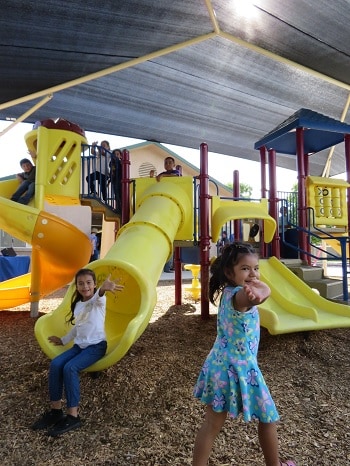
Children play under a shade structure funded by the American Academy of Dermatology.
Staying in the shade is an easy way to protect your skin, but many outdoor recreation areas do not have enough shade to help visitors stay out of the sun. The Shade Structure Program of the American Academy of Dermatology (AAD) gives money to schools, child care centers, parks, and nonprofit organizations to build permanent shade structures in places where children learn and play.
In 2015, AAD member Dr. Suzanne Olbricht provided seed money for a shade structure to be installed over the seal and sea lion exhibit at the Smithsonian Zoo in Washington, DC. More than 2 million people visit this exhibit every year, and the high-profile exposure prompted other AAD members to help fund shade structures in their communities. AAD also worked with the City of St. Petersburg, Florida, to make shade structures part of the remodeling of the St. Petersburg Pier. About 1.7 million visitors are expected to visit the new pier each year.
Building Shade Structures on Playgrounds and Sports Fields
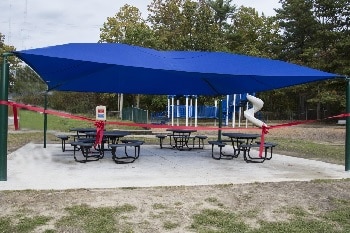
The shade structure at the Albert Bean Elementary School in Pine Hill, New Jersey.
In his travels around the Northeast, Neil Spiegler noticed that most of the playgrounds and sports fields he saw were “woefully unprotected from the dangerous rays of the sun,” with little shade for the players or the spectators.
As the director of the Peggy Spiegler Melanoma Research Foundation in South Jersey—and the grandfather of two boys who spend a lot of time on playgrounds and sports fields—Spiegler was keenly aware of the need to protect children and families from the dangers of too much sun exposure.
In 2017, the foundation built a shade structure at the Albert Bean Elementary School in Pine Hill, New Jersey, where Neil’s wife Peggy taught for almost 20 years. The freestanding shade structure can be used as an outdoor classroom as well as a place for parents and their children to stay sun-safe when using the playground.
Education
Skin Cancer Prevention Program in Nevada Schools
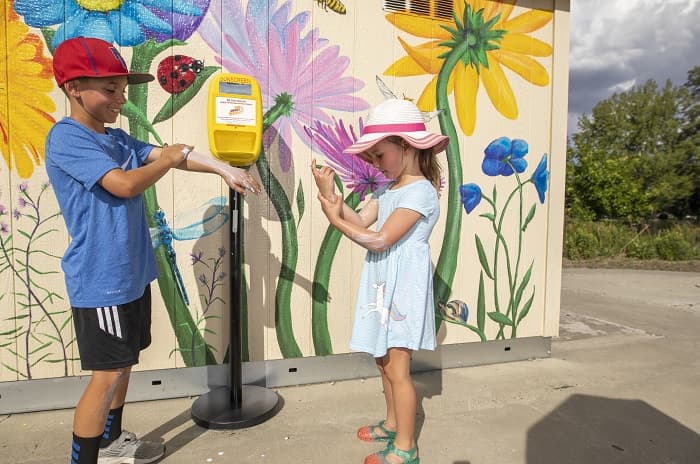
Kyle Davis and Hayley Davis apply sunscreen from a dispenser at a City of Reno park.
Damage from UV rays during childhood can cause skin cancer later in life. Nevada’s schools, however, had no programs in place for sun safety education or to support sun protection habits. The Nevada Cancer Coalition started the Sun Smart Schools program in seven schools in 2015. The program teaches students how to protect their skin from too much exposure to the sun. It also encourages schools to create sun safety policies, including providing shade and sunscreen to students on school grounds.
In just 3 years, the program expanded to 42 schools, but participation was voluntary and schools sometimes needed on-site champions to make sure school sunscreen policies were consistent with the program. State senator Joyce Woodhouse, a former elementary school principal whose husband died of melanoma, sponsored a bill that requires schools to adopt sun safety policies. The bill became law on July 1, 2019, and all public school districts in Nevada have adopted sun safety policies.
Schools can also choose to receive free automatic sunscreen dispensers and sunscreen. Thousands of students have received UV-activated bracelets, educational postcards, and bookmarks. Nevada Cancer Coalition staff and volunteers provide in-person and online sun safety presentations to teachers and students.
Campaign Helps Outdoor Workers Beat the Heat—and Skin Cancer
When you think of the dangers that outdoor workers face, cancer may not be at the top of the list. But the risk is very real. “Overexposure to the sun is the most common cause of skin cancer,” says Armand Sabitoni, labor co-chairman of the Laborers’ Health and Safety Fund of North America (the Fund). “With much of their time spent working outdoors, our members are at particularly high risk.”
The Fund helps outdoor workers prevent skin cancer by educating them and their employers about sun safety. Its Sun Sense Plus campaign explains that workers can protect their skin both on and off the job by wearing sunscreen, sunglasses, hats, and protective clothing, and employers can provide shade for workers. The campaign offers free posters and short publications about sun safety, as well as sunscreen, lip balm, and neck flaps.
A University Helps the Community Stay Sun-Safe

Health educators from the University of Arizona Skin Cancer Institute pose with their mascot. Photo courtesy of the University of Arizona Skin Cancer Institute.
The University of Arizona Skin Cancer Institute educates the public on skin cancer prevention and early detection strategies. As its early efforts expanded, it became apparent that its small staff could not meet requests for services.
“We couldn’t possibly meet the needs of our community with our limited staff, so we decided to use a resource the University has plenty of: students,” said Dr. Robin Harris, director. The institute piloted Project SASS (Students are Sun Safe) in 2010. Project SASS trains University of Arizona students in health sciences to become peer and community educators for skin cancer risk reduction. These students teach lessons on sun safety and skin cancer prevention in middle and high school classrooms.